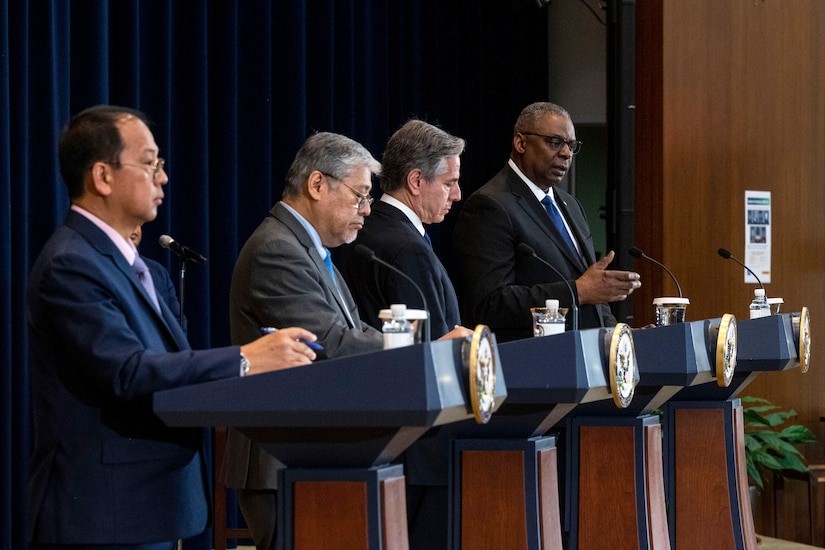Listen to our latest radio program at https://drive.google.com/file/d/1DMEE3JI7h9asbsfu-JN-Yy9dbeOPLBOA/view


Listen to our latest radio program at https://drive.google.com/file/d/1DMEE3JI7h9asbsfu-JN-Yy9dbeOPLBOA/view

Watch our latest TV program at https://rumble.com/v2klxpm-the-americanpolitical-zone-may-2-2023.html

China may be considered a land-based power, but it actively destabilizing global oceanic security and countries around the world are concerned. Philippine President Ferdinand “Bongbong” Marcos, Jr. wrapped up a four-day visit to Washington this week, where he met with the Biden White House, Members of US Congress, and Pentagon officials. With China ramping up threats to the Philippine’s sovereign territory, his US visit marks the first time during the Biden Administration that a foreign leader has received full honors at the Pentagon. The US is sending a message to China, but one that some analysts say Washington cannot or will not back up.
Secretary of Defense Lloyd Austin met with Marcos and a large delegation from Manila to discuss the evolving bilateral security relationship. In recent years, China has emerged as an increasingly belligerent power in East Asia. It has claimed Philippine territorial waters as its own, and stopped the country’s ships in open international waters, including recently one of its Coast Guard vessels traveling in the South China Sea. Since the November 2021 Bilateral Strategic Dialogue, the Philippines has sought to tighten its relationship with the US to ward off intensifying Chinese military aggression.
In Sri Lanka this week, the China Merchants Group, a state-run company, announced a $400 million investment to construct a logistics hub in the port at Colombo. It is predicted to be the largest in South Asia and is scheduled for completion in 2025. China will retain 70 percent ownership. Almost six years ago, China negotiated a 99-year lease to develop and manage the country’s Hambantota port. According to a China Merchants Group announcement this week, its total investments in the country are close to $2 billion. China uses all types of power to achieve its goals. The Sri Lanka port projects provide Beijing the ability to monitor the Indian Ocean and heavily traveled commercial shipping lanes.
Still further from its shores, in 2018 China proclaimed itself a “near Arctic state” and increasingly inserted itself into the Arctic region and the race for the riches of its seabed. Beijing gained observer status on the Arctic Council; the governing body composed of the eight Arctic nations. Beijing argues that it has scientific research, freedom of navigation, overflight, fishery, cable-laying and resource development rights in the Arctic high seas. China is collaborating with Russia to establish a global transport corridor using the Northern Sea Route (NSR) to avoid the lengthy trip through the Suze canal. Carving 40% off oceanic transit times would enable China to deliver products to Europe fast and at a lower cost. China labels the route its 21st Century Maritime Silk Route.
This week in the Antarctic Reuters is reporting there are concerns that China has resumed building its fifth Antarctic base. New satellite imagery developed by the Center for Strategic and International Studies (CSIS) taken in January shows that there are now support facilities, temporary buildings and a helipad, among other buildings. When finished the station will include a wharf for China’s Xuelong icebreaker ships. A Pentagon report last year suggests that the new infrastructure is designed to support claims Beijing is making for access to oceanic natural resources and espionage.
The southern shores of the Mediterranean today are the site of Chinese great power competition as there is a power vacuum left by America’s disengagement in the region. There are both hard and soft power elements at work as China increases ties to countries on important trade routes, with ports, and shipping facilities. Although China has not replaced the United States, it is increasing its ability to influence events in the southern Mediterranean.
In the America’s, a Chinese firm administers the Panama Canal. It is an important trade hub in the western hemisphere. The Panamanian government awarded the Chinese company Hutchinson-Whampoa concessions to operate the ports at each end and renewed the lease in 2021. Chinese ships consistently rank as the 2nd or 3rd largest users of the canal. At the Atlantic end of the canal, China’s Landbridge Consortium has committed $1 billion in investment funds to develop a new container port. There have been delays and some of China’s projects have been scaled back. Dredging for the port project is continuing. Today, about 45% of Panama’s population has some Chinese ancestry.
China’s long-term goal is to remake the global order in its own image and lead that system. It is a complicated, long-term, and expansive plan. Its tentacles extend to every major ocean body and nearby landmasses. Beijing designed a multi-decade plan and is using an aggressive, coordinated approach to diminish the leadership of the United States around the world and reduce Western democratic influence. Great power competition is heating up.
Daria Novak served in the U.S. State Dept.

International sanctions against a nation-state take time to impact its economy. Since Russia’s February 2022 invasion of Ukraine, under Putin’s so-called “special military operation,” it has faced increasing economic sanctions. One result is that Russia is “hemorrhaging” foreign firms currently based in the country, according to John Daly of the Jamestown Foundation. These companies are moving to former Soviet states, including many that are choosing Kazakhstan. At a government meeting in Astana on April 19, Prime Minister Alikhan Smailov said 43 firms are considering moving to Kazakhstan and 24 already have done so. Tengri News reports that those moving their base of operations include: Honeywell, InDriver, Weir Minerals, Ural Motorcycles, Fortescue, TikTok, Koppert and Emerson. Boeing, EPAM System, Youngsan, Skoda Transportation, GE Healthcare and Philips remain in discussion about the details of a similar move. As Putin’s war drags on into its second year, more foreign firms in Russia are growing concerned about the impact of increasingly harsh sanctions on their viability if they remain there. Kazakhstan recognized it as an opportunity for the Central Asian state and is courting these firms, hoping to attract large amounts of foreign direct investment (FDI) into the country to help modernize it.
Kazakhstan, as the largest and most prosperous of the Central Asian states, is using its economic power to attract these firms. It started the campaign to attract Russian-based companies one month after Putin invaded Ukraine. By the end of last year, Kazakh Deputy Minister of Foreign Affairs Almas Aidarov says Kazakhstan was negotiating with hundreds of Russia-based foreign firms about their possible relocation to his country. He noted in December that “Since the beginning of the conflict and the announcement of sanctions against the Russian economy, we have identified 362 companies that have publicly announced their withdrawal or reduction of their activities in the Russian market. These 362 companies are foreign companies that have operated in Russia and are of interest to us.”
Kazakhstan is attractive as an alternative platform. Kazakh President Tokaev’s administration is putting extensive effort into diversifying its economy. He wants to delink its over-reliance on hydrocarbon exports as well as attract more FDI. Tokaev considers the response to Russia’s invasion an unexpected windfall for his country. The US Department of State reports that according to official Kazakh central bank statistics, as of October 2021, FDI in Kazakhstan totaled $170 billion, including $40.4 billion from the US.
A Kazakh delegation traveling to Washington, DC and New York last year held meetings with Boeing, Valmont Industries, Honeywell, Pfizer, Champion Foods, Paramount, SMP Robotics, LA Solar Group, Ardmore Capital and JPMorgan Chase & Co. officials. Daly quotes Merzhan Iusupov, Chairman of the Board of Kazakh Invest, a national company responsible for attracting FDI to the country, as saying that “In connection with the relocation of many companies to Kazakhstan, we express our readiness to create all the institutional conditions for establishing direct interaction with foreign companies by providing opportunities for moving to Kazakhstan or opening joint ventures.” Since the US trip the flow of businesses leaving Russia has turned into a deluge of companies scrambling to leave.
Last week, in response to the loss of FDI, Putin signed a decree — “On the temporary management of certain property,” which established a mechanism for the introduction of temporary management of foreign assets in Russia, according to Daly. Vedomosti reports that it provides for the temporary management of Russian held subsidiaries of Finland’s Fortum Oyj and Germany’s Unipro (both energy companies) by the Federal Property Management Agency, to generate assets “of paramount importance for the stable functioning of the Russian energy sector.” Putin’s decree essentially establishes the government’s right to externally manage foreign assets inside Russia if Russian legal entities or individuals are deprived of the right of ownership of property abroad.
Putin’s actions are likely to encourage other foreign firms to leave Russia later this year, with Kazakhstan as the likely relocation site. Lloyds Bank in April reported that 70 percent of total regional FDI inflows in post-Soviet Central Asia go into Kazakhstan. As the leading Central Asian state continues down a path to reforming its legal and economic structures to attract more FDI, it appears the country will become the permanent base for many large firms once located inside Russia. The cost of Putin’s military incursion will have large and long-lasting impact on the Russian economy.
Daria Novak served in the U.S. State Dept.

There is little doubt that the United States faces unprecedented military threats. Questions are being raised about whether the current and proposed defense budgets reflect the current and prospective challenges.
Rep. Rob Wittman (R-Va) notes that “We are at a critical juncture in our nation’s history; we must decide if the United States will retain its global primacy, or if we will concede our position to the malign intent of Communist China. [We must meet] the reality of the threats facing the United States and to project power around the globe to deter our adversaries.”
Concern over the inadequacy of the Pentagon budget proposed by President Biden last year was reflected in the fact that there was a bipartisan consensus in Congress to add $16.7 billion to the figure he submitted.
Recently, Republican members of the Senate Armed Services Committee have stressed that “ The White House’s proposed figure for the coming year repeats the same poor judgement.” GOP leaders in the Senate state that “As threats to The United States proliferate, President Biden’s defense budget is woefully inadequate. [His] defense budget yet again fails to keep pace with the inflation… His proposed spending increases for the IRS and EPA vastly outpace the Pentagon, all while China continues its torrid pace of military modernization and expansion.”
Think tanks and media analysts concur with concerns about inadequate funding.
The Wall Street Journal editorial board reports that The White House’s Pentagon’s budget request, which doesn’t account for inflation, results in a 2.8% cut in spending power. At the same time, Biden advocates a 13.6% for both the Education and Energy Departments; 11.5% for Health and Human Services. For all the talk about a bloated Pentagon, defense in 2022 was only about 13% of the federal budget. It’s about 3% of GDP, down from 5% to 6% during the Cold War, even though America’s challenges today are arguably more numerous and acute. China is building a world-class military to drive America out of the Pacific. Russia is committed to grinding down Ukraine and then moving its military to the Polish border; Iran may soon have a nuclear bomb; North Korea is lobbing missiles toward Japan. Hypersonics and missiles threaten the U.S. homeland.”
Similarly, the American Enterprise Institute reviewed unfunded priorities in the proposed budget, which reach $16.9 billion. “… it is important to note that …the FY2024 lists do not yet include submissions from the Missile Defense Agency and US Cyber Command. … What is surprising is that the [unfunded priorities] do not include what will be necessary budget adjustments to account for realistic inflation projections, which will require at least another $21 billion to keep the budget equal in buying power to the start of FY2021 in September 2020.”
The United States Navy has been hit hard by underfunding at precisely the time when China and Russia have made serious bids to challenge it across the globe. Author Jerry Hendrix, in his Atlantic study published in March, warns that, starting with the Obama Administration, “both China and Russia developed systems that would challenge the U.S.-led regime of global free trade on the high seas. Russia began to invest in highly sophisticated nuclear-powered submarines with the intention of being able to disrupt the oceanic link between NATO nations in Europe and North America. China, which for a time enjoyed double-digit GDP growth, expanded both its commercial and naval shipbuilding capacities. It tripled the size of the People’s Liberation Army-Navy and invested in long-range sensors and missiles that could allow it to interdict commercial and military ships more than 1,000 miles from its shores. Both Russia and China also sought to extend territorial claims into international waters, the aim being to control the free passage of shipping near their shores and in their perceived spheres of influence. In short: Autocratic powers are trying to close the global commons.”
The nuclear threat is accelerating rapidly. China Is on pace To triple Its nuclear arsenal To 1,500 Warheads By 2035. Russia’s atomic weaponry already surpasses America’s in both numbers and modernization.
The White Houses’ proposed defense budget place the Unites States in immediate danger.
Photo: Army Spc. Christian Jaen Morales walks through dense foliage while conducting dismounted land navigation during a Non-Commissioned Officer of the Year and Soldier of the Year competition at Joint Base Lewis-McChord, Wash., April 4, 2023.

Relations between Manila, a long-time U.S. ally, and Washington deteriorated dramatically during the Obama Administration. The failure of the Obama Administration to respond to China’s 2013 aggression towards the Philippines was a crucial factor in the alienation.
The facts are harsh and undeniable. China took possession of almost every off-shore Philippine oceanic economic claim, although some access has been allowed. From the 2011 attack on Philippine fishing boats within Manila’s Exclusive Economic Zone and throughout the Obama Administration, America was essentially missing in action in response to the aggression. Overall, the Obama Administration did nothing, not evening lodging a diplomatic protest, to assist one of America’soldest regional allies.
Relations between the two nations improved markedly during the Trump Administration. That trend continues as China engages in increasingly belligerent actions in the region.
In April, U.S. and Philippine leaders met to discuss the nations’ military, economic and humanitarian partnership at a meeting in Washington.
Secretary of State Antony J. Blinken, Secretary of Defense Lloyd J. Austin III, Philippine Officer in Charge of the Department of National Defense Carlito Galvez Jr. and Philippine Secretary of Foreign Affairs Enrique A. Manalo gathered at the U.S. State Department in Washington D.C.
The Mutual Defense Treaty between the U.S. and the Philippines, signed in 1951, “remains the bedrock of our cooperation,” Austin said, noting that the treaty applies to armed attacks on either nation’s armed forces or public vessels anywhere in the South China Sea.
At the meeting, discussions included modernizing the Philippine armed forces and operationalizing the four new sites in Palawan and northern Luzon under the Enhanced Defense Cooperation Agreement, which was signed on Feb. 1.
Those four new sites are Naval Base Camilo Osias, Camp Melchor Dela Cruz, Balabac Island and Lal-lo Airport. The five existing sites are Cesar Basa Air Base, Fort Magsaysay Military Reservation, Lumbia Air Base, Antonio Bautista Air Base and Mactan Benito Ebuen Air Base.
These nine sites will support combined training exercises and military interoperability, Austin said, adding that by the end of fiscal year 2023, a forecasted $100 million in infrastructure will be invested at the sites.
The discussion also focused on “near-term plans to complete a security-sector assistance roadmap to support the delivery of priority defense platforms over the next five to 10 years, including radar, unmanned aerial systems, military transport aircraft and coastal- and air-defense systems,” Austin said. Talks included planning combined maritime activities with the U.S., Philippines and other ally and partner nations in the South China Sea later this year to enhance collective deterrence.
Austin mentioned that more than 17,000 troops are participating in Exercise Balikatan. It is the largest and most complex iteration of that annual exercise which began 38 years ago.
Blinken touted the economic partnership, including the Indo-Pacific Economic Framework for Prosperity with the Philippines and other partners across east and south Asia, as well as Australia and New Zealand.
Not unexpectedly, China has reacted angrily. According to Radio Free Asia, Beijing insists that “Granting the United States greater access to Philippine military bases will drag the Southeast Asian nation into ‘geopolitical strife.” to contain its growing regional influence.
The moves follow a statement in December by the U.S. State Department that “The United States supports the Philippines’ continued calls upon the People’s Republic of China (PRC) to respect the international law of the sea in the South China Sea, as reflected in the UN Convention on the Law of the Sea, and its legal obligations pursuant to the 2016 arbitral ruling. The reported escalating swarms of PRC vessels in the vicinity of Iroquois Reef and Sabina Shoal in the Spratly Islands interfere with the livelihoods of Philippine fishing communities, and also reflect continuing disregard for other South China Sea claimants and states lawfully operating in the region. Furthermore, we share the Philippines’ concerns regarding the unsafe encounter that the PRC Coast Guard initiated with Philippines naval forces in the South China Sea, as documented before the Senate of the Philippines on December 14.”
Photo: U.S., Philippine officials meet (DoD )

The federal government is addicted to spending. The vast amounts it outlays is less about making the nation better than it is about getting politicians re-elected.
The Tax Foundation reported in late 2022 that “federal tax collections are up 21 percent over the last year, according to the latest data from the Congressional Budget Office (CBO). Federal tax collections hit a record high of $4.9 trillion in nominal dollars for the fiscal year (FY) 2022 that ended September 30, which is $850 billion more than last year’s $4.05 trillion in collections (also a record). As a share of GDP, federal tax collections are at a multi-decade high of about 19.6 percent in FY 2022, up from 17.9 percent last fiscal year and approaching the last peak of 20 percent set during the dot-com bubble in FY 2000. There are only two other years in U.S. history when federal tax collections exceeded this year’s level, both during World War II: in 1943, federal tax collections reached 20.5 percent of GDP before falling to 19.9 percent in 1944. Compared to average federal tax collections in the post-war era of 17.2 percent of GDP, this year’s collections are set to exceed that level by 2.4 percentage points.”
Despite that, in FY 2022 there was a deficit of $1.38 trillion. Washington’s debt now stands at over $31 trillion, and, having reached a borrowing capacity of over $38 trillion, the White House is demanding an increase in that astronomical debt limit be raised without any considerations of cuts in future spending. That debt limit has been raised about eighty times since 1960. Despite the dire burden placed on taxpayers, President Biden is seeking even greater spending to be paid for by even higher taxes, and wants to hire more IRS agents to insure collections. Despite claims to the contrary, those agents will not be targeting the wealthy, who have attorneys and accountants on staff to defend them. They will be targeting small business owners, free-lance workers in the “gig” economy, and folks like waiters and waitresses whose income comes from tips. The Washington Times noted recently that “citizens reporting anywhere from no taxable income to $200,000 a year will experience the full force of the new IRS agents — a little less than a million more audits per year — compared with about 250,000 a year projected to be conducted on those making more than $200,000.”
The General Accounting Office has long warned that Washington’s spending addiction is a path to disaster, noting that “Growing debt is not just a number—it represents a threat to our economy and our ability to meet national needs and priorities…Rising federal debt could constrain Congress’ ability to support the economy or address other national priorities, reduce private investment & overall economic growth, erode confidence in the U.S. dollar.”
Much of that spending is not geared towards meeting real national needs. One example: Biden’s unconstitutional proposal to spend taxpayer dollars to forgive students loans was a bid to get support in the 2022 elections. Liz Wheeler, writing for Newsweek, called it a “desperate attempt to buy votes.”
A substantial portion of the $1.2 trillion dollar “infrastructure” package went to needs other than roads and bridges, transit and rail. The CATO Institute notes that rather than make decisive improvements, Biden seeks to “remake the nation’s infrastructure on the basis of his beliefs about labor unions and the environment,” essentially playing to his political base.
Don’t blame defense spending for the deficit. As war clouds undeniably gather, only about 13% of federal spending goes to the Pentagon. That’s actually less than what it was in many years over the past half century.
The sums extracted from taxpayers to Washington’s treasury should not be used as personal piggybanks for politicians. Neither the citizenry nor the nation can survive this massive descent into bankruptcy.
Illustration: Pixabay